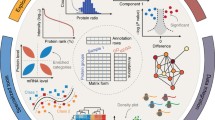Abstract
Protein expression profiling is a multidisciplinary research field which promises success for early cancer detection and monitoring of this widespread disease. The surface enhanced laser desorption and ionization (SELDI) is a mass spectrometry method and one of two widely used techniques for protein biomarker discovery in cancer research. There are several algorithms for signal detection in mass spectra but they are known to have poor specificity and sensitivity. Scientists have to review the analyzed mass spectra manually which is time consuming and error prone. Therefore, algorithms with improved specificity are urgently needed. We aimed to develop a peak detection method with much better specificity than the standard methods.
The proposed peak algorithm is divided into three steps: (1) data import and preparation, (2) signal detection by using an Analysis of Variance (ANOVA) and the required F-statistics, and (3) classification of the computed peak cluster as significant based on the false discovery rate (FDR) specified by the user.
The proposed method offers a significantly reduced preprocessing time of SELDI spectra, especially for large studies.
The developed algorithms are implemented in R and available as open source packages ProSpect, rsmooth, and ProSpectGUI. The software implementation aims a high error tolerance and an easy handling for user which are unfamiliar with the statistical software R. Furthermore, the modular software design allows the simple extension and adaptation of the available code basis in the further development of the software.
Preview
Unable to display preview. Download preview PDF.
Similar content being viewed by others
References
Benjamini, Y., Hochberg, Y.: Controlling the false discovery rate: a practical and powerful approach to multiple testing. J. R. Stat. Soc. B 57, 289–300 (1995)
Coombes, K.R., Fritsche, H.A., Clarke, C., Chen, J.-N., Baggerly, K.A., Morris, J.S., Xiao, L.-C., Hung, M.-C., Kuerer, H.M.: Quality control and peak finding for proteomics data collected from nipple aspirate fluid by surface-enhanced laser desorption and ionization. Clin Chem. 49(10), 1615–1623 (2003)
Etzioni, R., Urban, N., Ramsey, S., McIntosh, M., Schwartz, S., Reid, B., Radich, J., Anderson, G., Hartwell, L.: The case for early detection. Nat. Rev. Cancer 3(4), 243–252 (2003)
Fung, E., Diamond, D., Simonsesn, A.H., Weinberger, S.R.: The use of SELDI ProteinChip array technology in renal disease research. Methods Mol. Med. 86, 295–312 (2003)
Fung, E.T., Enderwick, C.: ProteinChip clinical proteomics: computational challenges and solutions. Biotechniques (suppl.) 34(8), 40–41 (2002)
Klose, J.: Protein mapping by combined isoelectric focusing and electrophoresis of mouse tissues. A novel approach to testing for induced point mutations in mammals. Humangenetik 26(3), 231–243 (1975)
Li, L., Tang, H., Wu, Z., Gong, J., Gruidl, M., Zou, J., Tockman, M., Clark, R.A.: Data mining techniques for cancer detection using serum proteomic profiling. Artif. Intell. Med. 32(2), 71–83 (2004)
Liao, J., Lin, Y., Selvanayagam, Z.E., Shih, W.J.: A mixture model for estimating the local false discovery rate in DNA microarray analysis. Bioinformatics 20(16), 2694–2701 (2004)
MacNeil, J.S.: Better biomarkers for the diagnostics labyrinth. Genome Technol., 24–33 (2004)
Molist, R., Gerbault-Seureau, M., Klijanienko, J., Vielh, P., Dutrillaux, B.: Potential rapid assessment of breast cancer prognosis using induced chromosome condensation performed on cytological specimens. Lab Invest 84(4), 433–439 (2004)
O’Farrell, P.H.: High resolution two-dimensional electrophoresis of proteins. J. Biol. Chem. 250(10), 4007–4021 (1975)
Pawitan, Y.: In All Likelihood: Statistical Modelling and Interence Using Likelihood. Oxford University Press, Oxford (2001)
Sullivan Pepe, M., Etzioni, R., Feng, Z., Potter, J.D., Thompson, M.L., Thornquist, M., Winget, M., Yasui, Y.: Phases of biomarker development for early detection of cancer. J. Natl. Cancer Inst. 93(14), 1054–1061 (2001)
Perou, C.M., Sørlie, T., Eisen, M.B., van de Rijn, M., Jeffrey, S.S., Rees, C.A., Pollack, J.R., Ross, D.T., Johnsen, H., Akslen, L.A., Fluge, O., Pergamenschikov, A., Williams, C., Zhu, S.X., Lønning, P.E., Børresen-Dale, A.L., Brown, P.O., Botstein, D.: Molecular portraits of human breast tumours. Nature 406(6797), 747–752 (2000)
Reiner, A., Yekutieli, D., Benjamini, Y.: Identifying differentially expressed genes using false discovery rate controlling procedures. Bioinformatics 19(3), 368–375 (2003)
Resing, K.A., Ahn, N.G.: Proteomics strategies for protein identification. FEBS Lett. 579(4), 885–889 (2005)
Shiwa, M., Nishimura, Y., Wakatabe, R., Fukawa, A., Arikuni, H., Ota, H., Kato, Y., Yamori, T.: Rapid discovery and identification of a tissue-specific tumor biomarker from 39 human cancer cell lines using the SELDI ProteinChip platform. Biochem. Biophys. Res. Commun. 309(1), 18–25 (2003)
Somiari, R.I., Somiari, S., Russell, S., Shriver, C.D.: Proteomics of breast carcinoma. J. Chromatogr B Analyt Technol Biomed Life Sci. 815(1-2), 215–225 (2005)
Tan, C.-S., Ploner, A., Quandt, A., Lehtiö, J., Pawitan, Y.: Signal detection of seldi measurements for identifying protein biomarkers. Biostatistics (submitted February 2005)
Weatherly, D.B., Atwood, J.A., Minning, T.A., Cavola, C., Tarleton, R.L., Orlando, R.: A heuristic method for assigning a false discovery rate for protein identifications from mascot database search results. Mol. Cell Proteomics ( February 2005)
Xiao, Z., Prieto, D., Conrads, T.P., Veenstra, T.D., Issaq, H.J.: Proteomic patterns: their potential for disease diagnosis. Mol. Cell Endocrinol. 230(1-2), 95–106 (2005)
Author information
Authors and Affiliations
Editor information
Editors and Affiliations
Rights and permissions
Copyright information
© 2005 Springer-Verlag Berlin Heidelberg
About this paper
Cite this paper
Quandt, A., Ploner, A., Tan, C.S., Lehtiö, J., Pawitan, Y. (2005). ProSpect: An R Package for Analyzing SELDI Measurements Identifying Protein Biomarkers. In: R. Berthold, M., Glen, R.C., Diederichs, K., Kohlbacher, O., Fischer, I. (eds) Computational Life Sciences. CompLife 2005. Lecture Notes in Computer Science(), vol 3695. Springer, Berlin, Heidelberg. https://doi.org/10.1007/11560500_13
Download citation
DOI: https://doi.org/10.1007/11560500_13
Publisher Name: Springer, Berlin, Heidelberg
Print ISBN: 978-3-540-29104-6
Online ISBN: 978-3-540-31726-5
eBook Packages: Computer ScienceComputer Science (R0)




